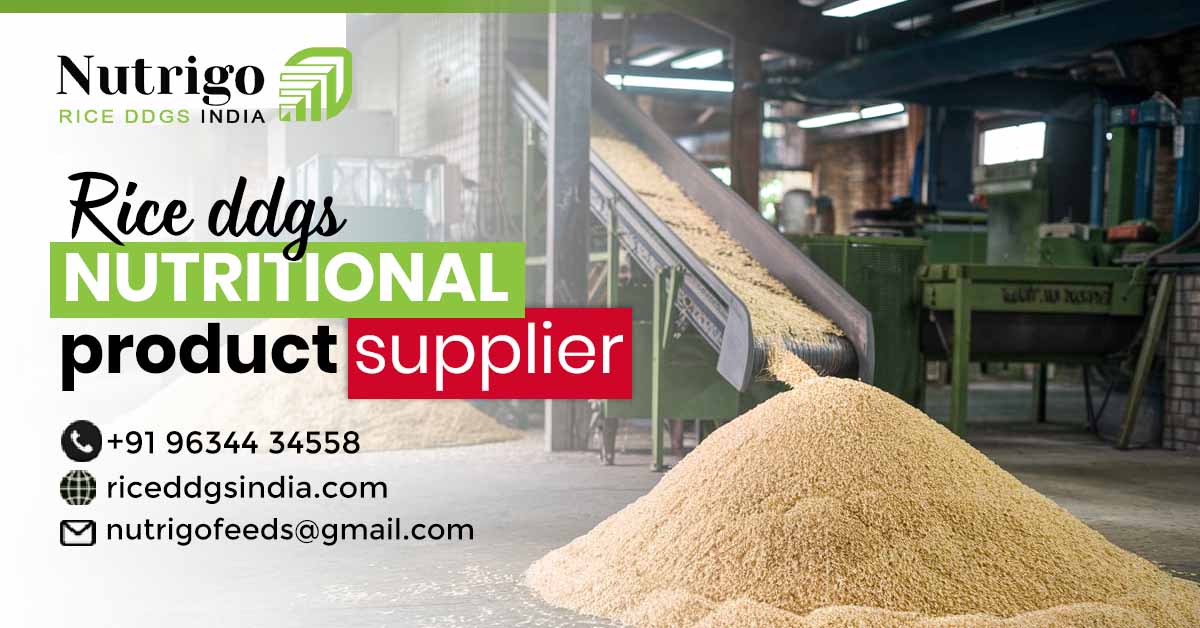rice ddgs nutritional product supplier – India is the largest producer and consumer of poultry and livestock products. There are over 300 million livestock and over 850 million poultry birds produced in the country, according to the Ministry of Agriculture. Such a large number indicates the demand for budget-friendly yet nutrient-rich feed remains on the rise. Hence, soybean meal, corn, and fishmeal are about to take a backseat as traditional feed ingredients. That is where Rice DDGs (Distillers Dried Grains) save the day. As a by-product of rice-based ethanol production, Rice DDGs emerge as a nutrient-rich and sustainable feed ingredient. Hence, high in protein, fibre, and energy, they are the perfect feed material for cattle, poultry, aqua, and even pigs.
Indian farmers now seek the top Rice DDGs nutritional product supplier to deliver consistent quality, digestibility, and value. Among them, Rice DDGS India is a brand of preference that fuels nutrition and growth through science-proven products.
How to Choose the Best Rice DDGs Nutritional Product Supplier
Selecting the right supplier is more than browsing product catalogues. Indian farmers need to look for the following:
Certifications: FSSAI, ISO, and GMP certifications guarantee that the product is healthy and safe.
Batch Testing: Get third-party lab reports. Hence, these guarantee protein content, fibre content, and absence of contaminants.
Customer Support: The ideal suppliers will guide the farmers on the ideal dosage and ratio to apply when blending for the different animals.
Product Variants: Others are in the form of fine powder or pellets so that they are easily mixed, stored, and digested.
Packaging Quality: Solid, waterproof packaging ensures freshness, especially in India’s volatile climate.
Delivery System: Rapid transport and local inventory minimise waiting time and allow ongoing supply of feed.
Brand Reputation: Being consistent and having positive word-of-mouth from other Indian farmers is going to portray a good supplier.
What Makes a Rice DDGs Nutritional Product Supplier Most Reliable in India?
• It is not just a matter of price and packaging to select the proper supplier. The manufacturers must sort out serious supply chain and quality control issues.
• The Rice DDGs nutritional value has to be uniform. Moreover, the supplier has to guarantee that the nutritional value in each batch is consistent. It has 35–40% protein, well-proportioned amino acids, and less than 12% moisture.
• Safety comes first. Quality suppliers regularly test for mycotoxins and heavy metals. Hence, they have clean processing and hermetically sealed packaging to guard against contamination.
• There is a need for traceability. Traceability of the raw material source incorporates transparency. Furthermore, it incorporates accountability if there is an issue regarding the quality.
• Although there can be lower costs, low-value DDGs lead to poor animal performance and health. Moreover, quality suppliers will pay fair prices and offer maximum nutritional value.
• Last but not least, farmers also look for after-sales services. Some companies offer Rice DDGs nutrient products along with technical support and dosage guides. Moreover, this makes the feed planning easy and increases efficiency.
Why Are Indian Farmers Switching to Rice DDGs for Animal Feed?
Strong Nutritional Profile Suits Indian Livestock Needs
India’s weather and different breeds call for a universal and healthy feed solution. Rice DDGs meet this need. Moreover, with a maximum of 40% protein and a high fibre content. Moreover, they enhance muscle building, improve digestion, and boost immunity. Rice DDGs nutritional value is uniform, providing consistency of performance. Cattle on DDGs produce more milk. These poultry animals gain weight quickly and have glossier feathers. In aquaculture, Rice DDGs’ digestibility provides improved FCR (feed conversion ratio).
Sustainable Production Helps Reduce Environmental Impact
Sustainability is more and more a characteristic of Indian agriculture. Rice DDGs are made from rice-based ethanol production from agro-residues instead of green crops. Hence, it also minimizes farm waste. Farmers, through the utilization of DDGs, minimize the demand for traditional feed crops like soybean and maize. Moreover, Indian Rice DDGs nutritional product supplier brands nowadays practise green manufacturing techniques.
Wide Applicability Across Species Adds Versatility
Indian farms typically have multiple animals on their farms—dairy cows, buffalo, broilers, goats, and fish. Having one feed component that can be used for all is an amazing convenience. Rice DDGs are that convenient. Hence, they can be added to specialty cattle, poultry, and aquaculture feed blends. For dairy animals, fibre in DDGs supports digestive function. For fish, digestibility equates to less waste and cleaner ponds. Rice DDGs also blend more easily with other components such as corn, bran, or mineral blends. Furthermore, it is convenient for farmers to maintain nutritional balance. Some product supplier brands offer custom blends for each species, supporting feed efficiency on every front.
Wrap Up
Consequently, the shift towards low-cost and environmentally friendly sources of animal feed is highly common in India. Choosing a good Rice DDGs nutritional product supplier ensures quality, safety, and service. However, manufacturers need a supplier that offers consistency, science-based nutrition, and guaranteed service. Rice DDGs India meets the demand with high-tech manufacturing and widespread distribution. By selecting Rice DDGS India as your business partner, you are getting healthier animals and lower feed costs.
Frequently Asked Questions
Q1. What are Rice DDGs made from?
They are derived from the residue of rice after ethanol manufacturing and contain more fibre and protein.
Q2. Are Rice DDGs suitable for all types of animals?
Yes, they are applied in poultry, dairy, aquaculture, and even swine breeding.
Q3. How are Rice DDGs stored for longer shelf life?
Store them in a dry, cool place in sealed containers to keep them fresh.
Q4. What’s the main advantage over traditional feeds?
They are high-protein foods with lower cost and lower environmental impact.


